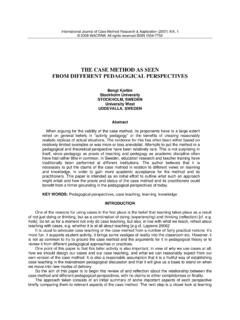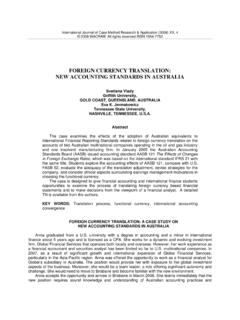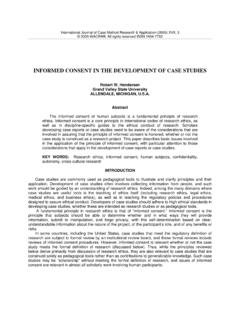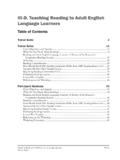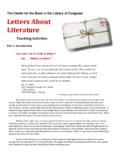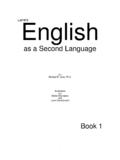Transcription of THE ROLES OF CASE STUDIES IN THE …
1 International Journal of case Method Research & Application (2005) XVII, 3 2005 WACRA . All rights reserved ISSN 1554-7752 THE ROLES OF case STUDIES IN THE EDUCATIONAL FIELD Janice L. Nath University of Houston-Downtown HOUSTON, TEXAS, Abstract This paper briefly describes several types of case STUDIES found in the field of education and their more common ROLES or uses. KEY WORDS: Education, scenario-based case STUDIES , teacher certification, case writing INTRODUCTION The field of education has a long history of using the case study (beginning as early as the 1920 s), perhaps as John Dewey s philosophy of real world application of content became more prevalent.
2 However, the use of case STUDIES has become of increasing interest to those in many areas of education and educational research since the 1980 s. Conceivably, one reason that the case study has become prominent as a teaching tool in more recent times is that it s use agrees with the most current philosophy of learning in education constructivism. Many educators find that learner-centered cases offer a much more constructivist way of teaching, in which instructors do not simply transfer knowledge to education students but help them build their own knowledge in a contextual, social, and interactive setting.
3 The process of using cases may also aid in students abilities to generate multiple pathways for certain circumstances and in the understanding that there may be multiple, acceptable decisions for particular situations. Thus, participating in cases may help to create more questioning and reflective educators. Cases also connect to motivation theory in that they are often seen as having direct and concrete application to the career chosen by students. Yet another reason for the spread of case study usage is the increased acceptance of qualitative research in the field of education in the past few decades, where researchers realize that valuable information can be gained through rich anecdotal study--particularly when experimentation or other quantitative methods are not possible or desired.
4 Because working in schools has always been demanding (with an extensive range of needed skills and activities), the case study has offered a number of ways to address those complexities found in the educational field, including areas such as teaching and learning, administration, educational psychology, multicultural STUDIES , special education, content areas, and so forth. The use of the case study may range from extended case projects, theses, and dissertations with in-depth research on schools, programs, types of students, etc., to much briefer decision sets, scenarios, simulations, or vignettes with short critical incidents designed to illustrate a specific example of an instructional or behavioral situation.
5 Simple and complex interactive videos may also be included as cases. The following discussion gives a brief description of the some of the major ROLES various types of case STUDIES perform in the educational field. SUPPLIMENTAL SCENARIO-BASED case STUDIES In the past decade, those involved in education have become increasingly aware that teachers who are ill-prepared for the ambiguity of real-life classrooms often leave the teaching profession quickly or fall International Journal of case Method Research & Application (2005) XVII, 3 397 back upon less current, reflective, or theoretical practice. The burden of teacher turnover is heavy both financially and in losing experienced, reflective teachers of high quality [National Commission on Teaching and America s Future, 2003].
6 Thus, those in many education programs have supported the benefits of early field experience in schools so that education students will be more prepared for the realities of schools before they enter their own classrooms as teachers-of-record. However, these experiences are not always what professors want for education students to observe and experience. Many colleges of education, for example, want to prepare students for urban experiences or to focus upon precise situations, but available placements in the field may not support these exact circumstances or concepts under consideration--nor can a shared experience or frame of reference for a group or class be guaranteed in field placements.
7 However, the scenario-based case study can be designed to pinpoint a specific purpose. Educators, therefore, have increasing begun to author short (1-5 page) clips that quickly involve the reader into a real or constructed (but true-to-life ), highly specific situation. These scenario cases are often followed by a limited number of discussion/reflection questions that ask education students or inservice teachers to consider the facts and feelings in the situation and apply effective, educated, thoughtful decisions. This allows the author and/or the user to control a specific concept or illustrate an exact example.
8 This type of case study is currently found in most new texts in various education fields (often as an introduction to a chapter or as a part of closing activities in a chapter), on many supporting Web sites for these texts, and also as video clip cases on some of these Web sites. There are also a limited number of texts written with these types of scenario-based case STUDIES for various educational purposes such as Learning from Cases: Unraveling the Complexities of Elementary Science Teaching [Tippins, Koballa, & Payne, B., 2002], case STUDIES about Children and Adolescents with Special Needs [Halmhuber & Beauvais, 2002], Teaching in Today s Classrooms: Cases from Middle and Secondary School [Redman, 1999], case STUDIES in Adapted Physical Education: Empowering Critical Thinking [Hodge, Murata, Block, & Lieberman, 2000] and case STUDIES , Applying Educational Psychology [Jackson & Ormrod, 1998].
9 Other texts include cases for adult education, art education, teacher problem solving, music education, and so forth. Some of these types of books and/or cases come with a brief instructor s manual that most often gives anticipated responses and conclusions or generalizations that might develop from the cases. The types of cases contained in books of case STUDIES mentioned above, or within text chapters, are most often used as (1) whole-class discussion openers, (2) supplemental assignments for individual students, or (3) small group discussion activities. These types of cases are used both in preservice and graduate, education-related classrooms but may also serve as a resource for inservice teacher professional development.
10 These types of vignettes can also be essential to offering vicarious experiences for those who are teaching distance courses in education where there is no face-to-face interaction between the professor and the students. CaseNEX , for example, offers online professional development by delivering a case -based approach to teacher training. The Bilingual/ESL Endorsement through Distance Education site also offers video-anchored cases about inclusion of special needs populations, teaching of second languages, formal and informal assessment, and so forth. IN TIME gives step-by-step instructions on how to assemble a video case study for the classroom or for use in distance education courses.
